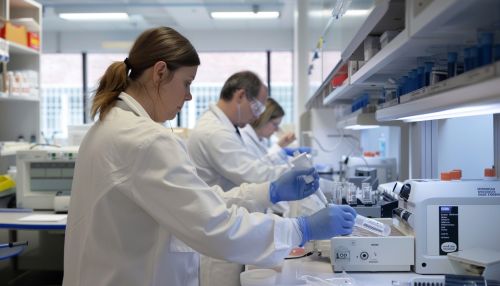Center for Biologics Evaluation and Research
Overview
The Center for Biologics Evaluation and Research (CBER) is a branch of the U.S. Food and Drug Administration (FDA) responsible for ensuring the safety, efficacy, and security of biological products. These products include vaccines, blood and blood products, tissues, and cellular and gene therapies. CBER's mission is to protect and enhance public health through the regulation of these biologics, ensuring that they meet rigorous scientific and regulatory standards.
History
CBER was established in 1988, evolving from the Bureau of Biologics, which was part of the National Institutes of Health (NIH). The center was created to consolidate the regulation of biological products under one entity within the FDA, reflecting the increasing complexity and importance of biologics in modern medicine. Over the years, CBER has played a pivotal role in responding to public health emergencies, such as the HIV/AIDS crisis in the 1980s and the COVID-19 pandemic in the 2020s.
Organizational Structure
CBER is organized into several offices and divisions, each specializing in different aspects of biologics regulation:
Office of the Director
The Office of the Director oversees all CBER activities, setting strategic priorities and ensuring coordination among the various offices and divisions. The Director is responsible for representing CBER within the FDA and to external stakeholders, including other government agencies, industry, and the public.
Office of Vaccines Research and Review (OVRR)
The OVRR is responsible for the regulation of vaccines and related products. This office conducts reviews of investigational new drug applications (INDs), biologics license applications (BLAs), and supplements to ensure that vaccines are safe and effective. The OVRR also engages in research to support regulatory decision-making and to advance the science of vaccinology.
Office of Blood Research and Review (OBRR)
The OBRR focuses on the regulation of blood and blood products, including blood components, plasma derivatives, and blood substitutes. This office ensures the safety and availability of the blood supply through rigorous review processes and surveillance activities. The OBRR also conducts research to improve blood safety and to develop new blood products.
Office of Cellular, Tissue, and Gene Therapies (OCTGT)
The OCTGT regulates cellular therapies, tissue products, and gene therapies. This office reviews INDs, BLAs, and other submissions to ensure that these advanced therapies meet safety and efficacy standards. The OCTGT also engages in research to support the development of new therapies and to address regulatory challenges.
Office of Compliance and Biologics Quality (OCBQ)
The OCBQ is responsible for ensuring that biological products are manufactured in compliance with regulatory requirements. This office conducts inspections of manufacturing facilities, reviews quality systems, and takes enforcement actions when necessary. The OCBQ also provides guidance to industry on compliance issues.
Regulatory Framework
CBER operates under a complex regulatory framework that includes laws, regulations, and guidance documents. Key legislative authorities include the Public Health Service Act and the Federal Food, Drug, and Cosmetic Act. These laws provide the legal basis for CBER's regulatory activities and grant the FDA the authority to oversee the development, manufacturing, and distribution of biological products.
CBER also issues guidance documents to help industry understand regulatory expectations and to provide clarity on specific regulatory issues. These documents are developed through a public process that includes stakeholder input and scientific review.
Research and Development
CBER conducts and supports research to advance the science of biologics and to inform regulatory decision-making. This research is carried out by CBER scientists and through collaborations with external partners, including academic institutions, industry, and other government agencies.
Key areas of research include:
- Vaccine development and evaluation
- Blood safety and availability
- Cellular and gene therapy development
- Tissue engineering and regenerative medicine
- Biostatistics and bioinformatics
CBER's research activities are designed to address regulatory challenges, improve product safety and efficacy, and support the development of new and innovative biologics.
Public Health Impact
CBER plays a critical role in protecting public health by ensuring the safety and effectiveness of biological products. The center's regulatory activities help to prevent and control infectious diseases, improve the safety of the blood supply, and support the development of new therapies for serious and life-threatening conditions.
CBER's work has had a significant impact on public health, including:
- The approval of vaccines that have eradicated or controlled infectious diseases such as smallpox, polio, and measles.
- The regulation of blood products that have improved the safety of blood transfusions and reduced the risk of transfusion-transmitted infections.
- The approval of advanced therapies, such as gene therapies, that offer new treatment options for patients with rare and serious diseases.
Challenges and Future Directions
CBER faces several challenges in its mission to regulate biological products. These challenges include the rapid pace of scientific and technological advancements, the complexity of biologics, and the need to balance innovation with safety and efficacy.
To address these challenges, CBER is focused on several key initiatives:
- Enhancing regulatory science to keep pace with advancements in biologics.
- Improving the efficiency and transparency of the regulatory process.
- Strengthening collaborations with stakeholders, including industry, academia, and other government agencies.
- Addressing emerging public health threats, such as pandemics and bioterrorism.
CBER is committed to continuing its mission to protect and enhance public health through the regulation of biological products. The center's work is essential to ensuring that biologics are safe, effective, and available to meet the needs of patients and the public.
See Also
- Food and Drug Administration
- Vaccinology
- Gene Therapy
- Public Health Service Act
- Federal Food, Drug, and Cosmetic Act


